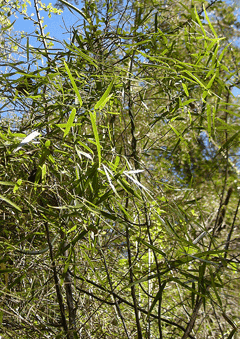 |
|
|
 |
| http://www.flickr.com/people/12017190@N06 |
Translate this page:
Summary
Physical Characteristics

 Geitonoplesium cymosum is an evergreen Perennial Climber growing to 4 m (13ft 1in).
Geitonoplesium cymosum is an evergreen Perennial Climber growing to 4 m (13ft 1in).
See above for USDA hardiness. It is hardy to UK zone 9 and is frost tender. The species is hermaphrodite (has both male and female organs) and is pollinated by Insects.
Suitable for: light (sandy), medium (loamy) and heavy (clay) soils. Suitable pH: mildly acid, neutral and basic (mildly alkaline) soils. It can grow in semi-shade (light woodland) or no shade. It prefers moist soil.
UK Hardiness Map
US Hardiness Map
Synonyms
Plant Habitats
Woodland Garden Sunny Edge; South Wall. By. West Wall. By.
Edible Uses
Edible Parts: Leaves Shoots
Edible Uses:
Young shoots - cooked. They make a fine substitute for asparagus[2, 154, 177, 193].
References More on Edible Uses
Medicinal Uses
Plants For A Future can not take any responsibility for any adverse effects from the use of plants. Always seek advice from a professional before using a plant medicinally.
None known
References More on Medicinal Uses
The Bookshop: Edible Plant Books
Our Latest books on Perennial Plants For Food Forests and Permaculture Gardens in paperback or digital formats.

Edible Tropical Plants
Food Forest Plants for Hotter Conditions: 250+ Plants For Tropical Food Forests & Permaculture Gardens.
More

Edible Temperate Plants
Plants for Your Food Forest: 500 Plants for Temperate Food Forests & Permaculture Gardens.
More

More Books
PFAF have eight books available in paperback and digital formats. Browse the shop for more information.
Shop Now
Other Uses
References More on Other Uses
Cultivation details
Prefers a humus-rich loamy soil[1]. There is very little information about growing this plant in Britain but it succeeds in most soils when grown in a shady position in Australian gardens[157]. It is likely to require a sunny sheltered position in this country[K]. This species requires greenhouse protection in Britain[1]. The plants are hardy to at least -7°c in Australian gardens[157] but this cannot be translated directly to British gardens due to our cooler summers plus our longer, colder and wetter winters. The plants produce new growth from a tuberous rootstock, and it is most likely that this root is hardier than the top-growth. It would therefore be worthwhile giving a good protective mulch to the roots over the winter to increase the chances of the plants survival[K]. A climbing plant, supporting itself by twining around the thin branches of other plants[K]. The flowers, which are borne in terminal cymes, are sweetly scented[245].
References Carbon Farming Information and Carbon Sequestration Information
Temperature Converter
Type a value in the Celsius field to convert the value to Fahrenheit:
Fahrenheit:
The PFAF Bookshop
Plants For A Future have a number of books available in paperback and digital form. Book titles include Edible Plants, Edible Perennials, Edible Trees,Edible Shrubs, Woodland Gardening, and Temperate Food Forest Plants. Our new book is Food Forest Plants For Hotter Conditions (Tropical and Sub-Tropical).
Shop Now
Plant Propagation
Seed - sow spring in a greenhouse[1]. Germination is sporadic and some seed can take more than 12 months. Pot up the plants when they are large enough to handle and grow them on in the greenhouse for at least their first 2 winters. If trying them outdoors, plant them out in early summer and give some winter protection for their first year or two. Division.
Other Names
If available other names are mentioned here
Native Range
AUSTRALASIA: Australia
Weed Potential
Right plant wrong place. We are currently updating this section.
Please note that a plant may be invasive in one area but may not in your area so it's worth checking.
Conservation Status
IUCN Red List of Threatened Plants Status :

Growth: S = slow M = medium F = fast. Soil: L = light (sandy) M = medium H = heavy (clay). pH: A = acid N = neutral B = basic (alkaline). Shade: F = full shade S = semi-shade N = no shade. Moisture: D = dry M = Moist We = wet Wa = water.
Now available:
Food Forest Plants for Mediterranean Conditions
350+ Perennial Plants For Mediterranean and Drier Food Forests and Permaculture Gardens.
[Paperback and eBook]
This is the third in Plants For A Future's series of plant guides for food forests tailored to
specific climate zones. Following volumes on temperate and tropical ecosystems, this book focuses
on species suited to Mediterranean conditions—regions with hot, dry summers and cool, wet winters,
often facing the added challenge of climate change.
Read More
Expert comment
Author
(R.Br.)A.Cunn.
Botanical References
1154
Links / References
For a list of references used on this page please go here
Readers comment